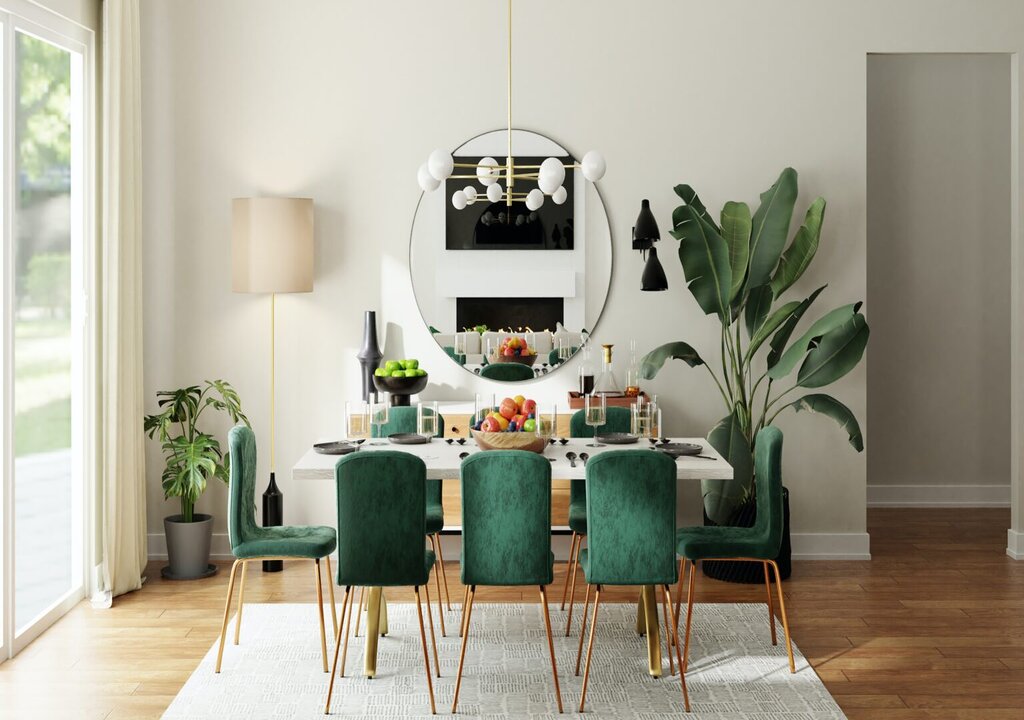Introduction
In the dynamic world of interior design, a new and exciting trend is making waves. This trend marries the opulence of luxury with a deep respect for our environment. Welcome to the realm of “Sustainable Luxury: Choosing Eco-Friendly Furniture.” Here, the story goes beyond just visual appeal. It’s about making a conscious choice for Green Living and Sustainable Design. This shift towards Eco Design is not just a fad, but a response to the growing awareness about the state of our planet. More and more people are choosing Natural Furniture and Recycled Furniture for their homes, not just because it’s trendy, but because it’s the right thing to do.
In this article, we will delve into the world of Sustainable Luxury and Eco-friendly Furniture. We will explore how you can transform your home into an Eco Home, filled with Environmentally Friendly Home Decor. We will guide you on your journey towards creating a Sustainable Home, where every piece of furniture is a testament to your commitment to preserving our planet.
So, let’s embark on this journey together, exploring the myriad ways in which we can indulge in luxury while still being kind to our Earth. Because luxury doesn’t have to come at the expense of the environment. In fact, as we will discover, true luxury lies in harmony with nature.
The Environmental Impact of Conventional Furniture

Resource Depletion and Deforestation: The traditional furniture manufacturing industry has long been a significant contributor to resource depletion and deforestation. The demand for exotic hardwoods, often used in high-end furniture, has led to the indiscriminate felling of trees, causing the destruction of habitats and the depletion of our planet’s precious ecosystems.
This practice not only threatens biodiversity but also contributes to climate change. Forests play a crucial role in sequestering carbon dioxide, and their destruction releases this stored carbon back into the atmosphere, exacerbating global warming.
Moreover, the extraction process itself often involves energy-intensive methods and heavy machinery, further increasing the industry’s carbon footprint. Additionally, the transportation of these raw materials across the globe adds another layer of environmental impact in the form of carbon emissions.
The allure of exotic woods and the desire for luxury items can sometimes overshadow the ecological toll exacted by these conventional practices. However, as awareness grows, so does the understanding that this path is not sustainable in the long run.
This section aims to shed light on these issues, highlighting the urgent need for a shift in our approach to furniture design and manufacturing. It underscores the importance of moving towards eco-friendly furniture and sustainable design practices that prioritize the use of recycled materials and locally sourced hardwoods, reducing the strain on our planet’s resources.
The transition to sustainable luxury is not just about creating environmentally friendly home decor. It’s about making a conscious decision to support practices that respect and preserve our natural world. It’s about choosing a sustainable home filled with eco-friendly furniture, where every item tells a story of respect for nature and commitment to its preservation. It’s about realizing that our choices matter and that we can make a difference.
In the following sections, we will explore how we can make these choices and transform our homes into spaces that reflect our commitment to sustainable living and eco design. Because luxury and sustainability can, and should, go hand in hand.
Carbon Footprint in Manufacturing Processes: The carbon footprint of conventional furniture production extends far beyond the initial resource consumption. Every step of the manufacturing process, from the energy-intensive factories to the transportation of raw materials, contributes to the overall environmental impact. Factories that produce traditional furniture often rely on fossil fuels for energy, leading to substantial greenhouse gas emissions. These emissions are a significant contributor to climate change, further exacerbating the environmental issues we face today. The transportation of raw materials also plays a significant role in the carbon footprint of furniture production. Materials are often sourced from various locations around the globe, requiring extensive shipping and transportation. This not only increases carbon emissions but also contributes to other forms of pollution, such as air and water pollution from shipping vessels. Furthermore, the manufacturing process itself can involve harmful chemicals and finishes that can be detrimental to both the environment and human health. These substances can pollute the air, soil, and water, causing harm to ecosystems and biodiversity.

Understanding these aspects is crucial as it sheds light on the environmental repercussions of our furniture choices. It emphasizes the need for a shift towards eco-friendly furniture and sustainable design practices that reduce carbon emissions and environmental impact. By choosing sustainable luxury and eco-friendly furniture, we can significantly reduce the carbon footprint of our homes. This involves selecting furniture made from recycled or sustainably sourced materials, opting for manufacturers that use renewable energy sources, and choosing locally made products to reduce transportation emissions.
Low Voc (Volatile Organic Compound) Finishes
Traditional furniture finishes often contain a range of chemicals that can release harmful Volatile Organic Compounds (VOCs) into the air. These VOCs contribute significantly to indoor air pollution, which can have adverse effects on both human health and the environment. VOCs are a group of carbon-based chemicals that easily evaporate at room temperature. Many of these compounds are known to be harmful, causing symptoms ranging from headaches and dizziness to more severe health problems like damage to the liver, kidney, and central nervous system.
In the context of furniture, these compounds are often found in the finishes and adhesives used in the manufacturing process. When released into the air, they can contribute to the formation of ground-level ozone, a key component of smog, and other types of air pollution. Sustainable luxury furniture, on the other hand, opts for low VOC finishes. These finishes are made from natural or plant-based materials that are less harmful to both the environment and the inhabitants of the space. They not only reduce indoor air pollution but also contribute to a healthier living environment.
Choosing furniture with eco-friendly finishes is an important aspect of creating a sustainable home. It’s not just about selecting furniture that looks good, but also about choosing pieces that are good for our health and the health of our planet. In the following sections, we will explore more about these eco-friendly finishes and how they contribute to sustainable design and green living. We will also look at other aspects of eco-friendly furniture, such as the use of recycled materials and sustainable manufacturing practices. Because when it comes to creating a sustainable home, every choice matters. From the materials used to the finishes applied, each decision contributes to the overall sustainability of the space. And that’s what sustainable luxury is all about – making choices that are not only luxurious but also kind to our planet.
Innovative Design And Functionality
Integration of Smart and Sustainable Technologies
Sustainable luxury is not just about the materials used in furniture. It’s also about how that furniture functions in our daily lives. The integration of smart technologies into furniture design is a growing trend that enhances convenience and contributes to energy efficiency, marking a significant step forward in eco-conscious design. Smart furniture refers to pieces that incorporate technology to provide added functionality. This could include anything from built-in charging ports and wireless connectivity to adjustable settings for comfort and convenience. But it’s not just about adding bells and whistles. When done right, smart furniture can contribute to energy efficiency and sustainability. For example, consider a smart lamp integrated into a side table. This lamp could be programmed to adjust its brightness based on the time of day or the level of ambient light in the room, reducing unnecessary energy consumption. Or think about a smart thermostat integrated into a wall unit that learns your schedule and adjusts the temperature accordingly, optimizing energy use. These smart technologies not only make our lives easier but also help us reduce our carbon footprint. They allow us to enjoy the comforts of modern living while still being mindful of our impact on the environment.

Modular and Multi-functional Furniture Designs
In the realm of sustainable luxury, versatility is key. This is where modular and multi-functional furniture designs come into play. These innovative designs allow furniture to adapt to changing needs, reducing the need for constant replacements and contributing to a more sustainable lifestyle.
Modular furniture refers to designs that can be easily assembled, disassembled, and reconfigured to suit different purposes. This flexibility allows you to change the layout of your space without having to purchase new pieces, reducing waste and promoting a more sustainable approach to interior design.
Multi-functional furniture, on the other hand, combines multiple uses into a single piece. Think of a coffee table that can be expanded into a dining table, or a sofa that can be transformed into a bed. These designs not only save space but also reduce the need for multiple pieces of furniture, further contributing to sustainability.
These versatile designs are a testament to how form meets function in the world of sustainable furniture. They showcase the creativity and innovation that is driving the shift towards more sustainable practices in the furniture industry. Because in the world of sustainable luxury, versatility is not just a trend, it’s a necessity. It’s about creating pieces that are not only beautiful and luxurious but also adaptable and sustainable. It’s about understanding that our needs and circumstances can change, and that our furniture should be able to change with them. It’s about embracing a new way of thinking about furniture, one that puts sustainability and adaptability at the forefront.
Tips For Making Sustainable Furniture Choices
Researching and Verifying Certifications
In the journey towards sustainable luxury, knowledge is indeed power. It’s crucial to arm oneself with the right information to make informed decisions. This is particularly true when it comes to choosing eco-friendly furniture. With a plethora of options available in the market, how can one distinguish truly sustainable options from those that are merely greenwashed?
One practical way is by researching and verifying certifications. Many reputable organizations provide certifications for eco-friendly furniture, attesting to their sustainability and environmental impact. These certifications consider various factors, such as the source of the materials, the manufacturing process, the use of chemicals, and the product’s overall life cycle.
However, not all certifications are created equal. Some are more rigorous than others, and some may even be misleading. Therefore, it’s essential to understand what each certification means and what standards it upholds.
Here are some tips on researching and verifying certifications:
- Understand the Certification: Research what each certification entails. What standards does it uphold? What criteria does a product need to meet to receive the certification?
- Check the Certifying Body: Look at who is providing the certification. Is it a reputable organization? Do they have a rigorous process for certification?
- Verify the Certification: Don’t just take the manufacturer’s word for it. Check the certifying body’s website to verify the certification. Some organizations provide a searchable database of certified products.
- Beware of Greenwashing: Be cautious of vague or misleading terms like ‘eco-friendly’ or ‘natural’ without any certification to back up these claims. These could be signs of greenwashing.
By arming oneself with the right information and understanding how to verify certifications, one can make more informed decisions and choose truly sustainable furniture options. Remember, every choice matters in our journey towards sustainable luxury. Let’s make choices that are kind to our planet and create a sustainable home that we can be proud of. Because sustainable luxury is not just a trend, it’s a lifestyle.

Understanding the Lifecycle of Furniture Products
When it comes to making sustainable choices, it’s essential to look beyond the showroom floor. The true environmental impact of a piece of furniture is determined by its entire lifecycle, from production to disposal. This holistic perspective allows consumers to assess the sustainability of their purchases more accurately.
The lifecycle of a furniture product typically includes the following stages:
- Material Extraction: This is the first stage of the lifecycle, where raw materials are extracted for use in the product. The sustainability of this stage depends on factors such as the type of material used (e.g., whether it’s a renewable resource), the method of extraction, and the distance the materials need to travel to the manufacturing site.
- Manufacturing: This stage involves transforming the raw materials into a finished product. The sustainability of this stage is determined by factors such as the amount of energy used in the process, the type of energy (e.g., renewable or non-renewable), and the amount of waste produced.
- Distribution: Once the product is manufactured, it needs to be transported to retailers. The sustainability of this stage depends on the distance the product needs to travel and the mode of transportation used.
- Use: This is the stage where the product is used by the consumer. The sustainability of this stage can be influenced by factors such as the product’s durability (i.e., how long it lasts before it needs to be replaced) and whether it’s designed to be multi-functional or modular, reducing the need for additional furniture.
- End of Life: The final stage of the lifecycle is when the product is disposed of. The sustainability of this stage depends on whether the product can be recycled or composted, or whether it ends up in a landfill.
By understanding the lifecycle of furniture products, consumers can make more informed decisions about their purchases. They can choose products that are not only sustainable in their materials but also in their manufacturing, distribution, use, and end-of-life stages.
Because when it comes to sustainable luxury, every stage matters. It’s about making choices that are good for our planet, from start to finish. Because sustainable luxury is not just about what we buy, but also about how it’s made, used, and disposed of. It’s about taking a holistic approach to sustainability, one that considers the entire lifecycle of a product. And that’s what true sustainable luxury is all about.
Conclusion
The intersection of luxury and sustainability in the world of furniture is not just a possibility, but an imperative in our current environmental context. As we navigate through the challenges of climate change and resource depletion, the choices we make in our homes can have a profound impact on our planet. Understanding the nuances of eco-friendly furniture choices is the first step towards becoming ambassadors of change. It’s about recognizing that every piece of furniture has a story – a story of its materials, its manufacturing process, its use, and its end of life. And it’s about choosing pieces whose stories reflect our commitment to sustainability. By opting for sustainable luxury, we are not just enhancing the aesthetic appeal of our spaces. We are also shaping a more sustainable future, one piece of furniture at a time. We are making a statement about the kind of world we want to live in and the values we want to uphold.
So, let’s embrace sustainable luxury. Let’s choose eco-friendly furniture. Let’s transform our homes into spaces that are not just beautiful, but also kind to our planet. Because in the end, sustainable luxury is not just about furniture. It’s about us, our choices, and the future we want to create.
Thank you for joining us on this journey towards sustainable luxury. We hope that this article has provided you with valuable insights and practical tips on choosing eco-friendly furniture. Remember, every choice matters. Let’s make choices that count. Let’s make choices that are good for us and good for our planet. Because that’s what sustainable luxury is all about.







